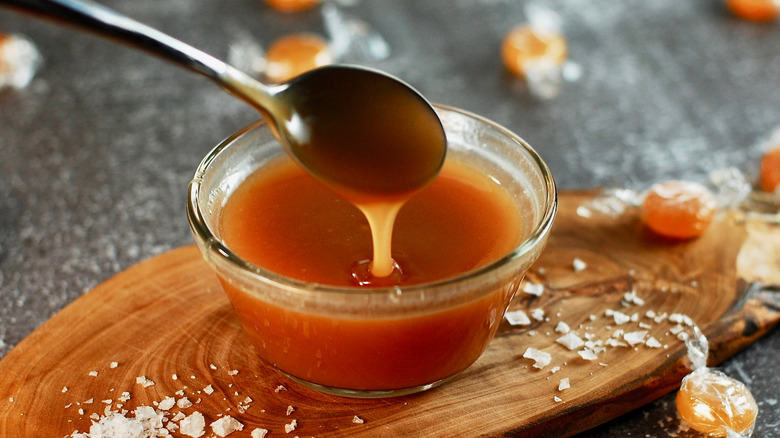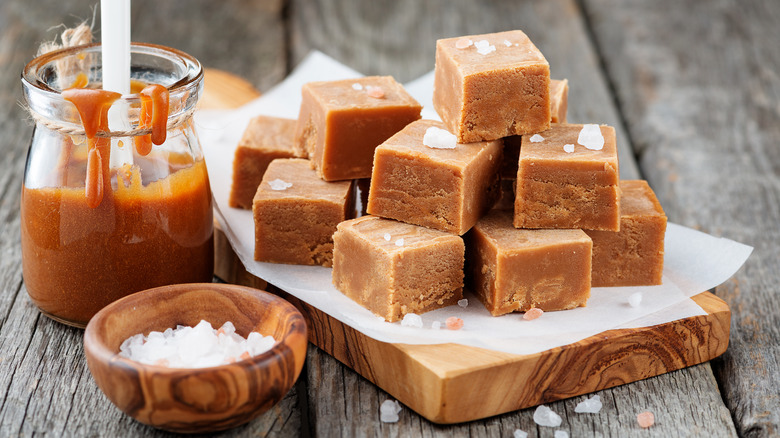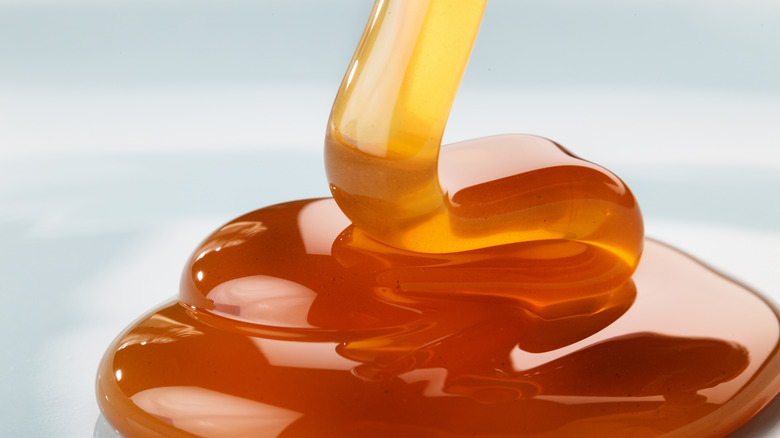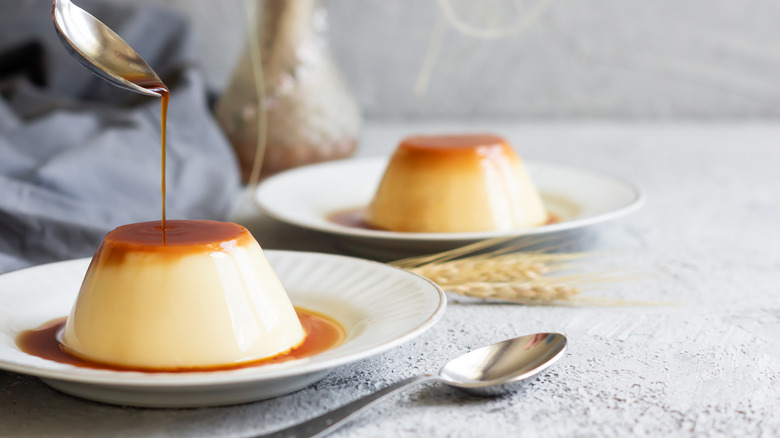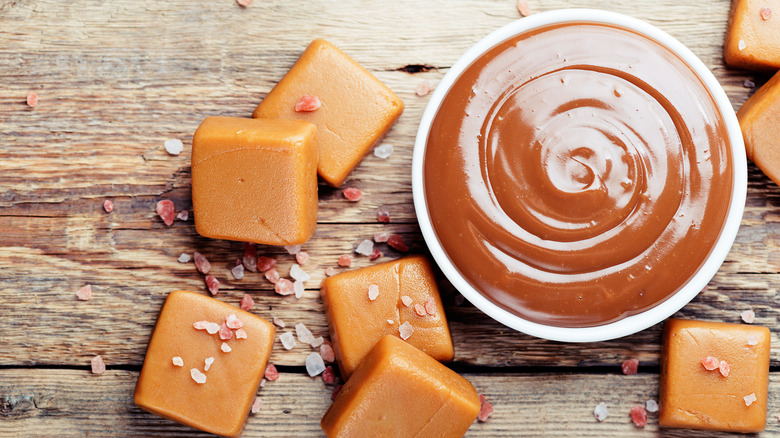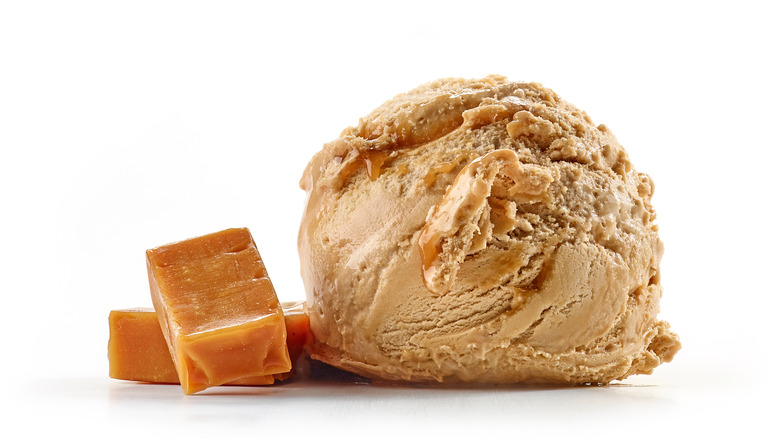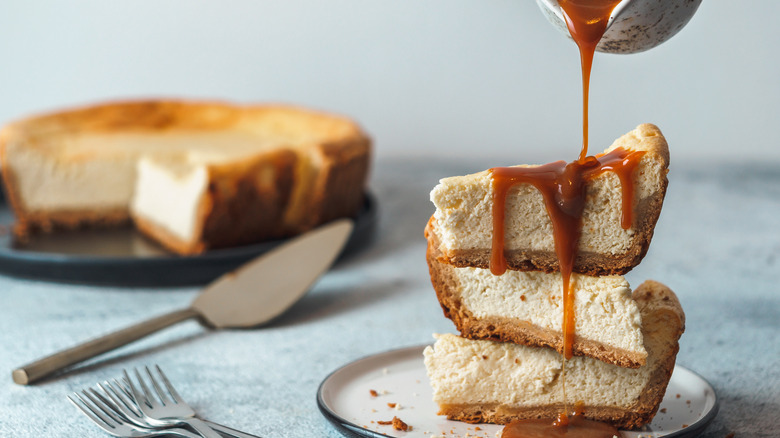Everything You Need To Know About Caramel
If you don't like to brand yourself as a chocolate person, chances are it's because you have a soft spot for caramel instead. Perhaps you like to eat caramel as a sauce, squeezed out of a bottle and onto a stack of pancakes. Maybe, you like liquid caramel oozing out of a hot cake, much like chocolate does in a choco lava cake. Or maybeyou eat it as a candy — either soft and chewy enough to get stuck between your teeth, or so hard that it feels like the caramel candy will knock break all your teeth
No matter how you like your caramel, you have the Arabs of 1000 A.D. to thank for the amber-colored confection (via Our Everyday Life). Contrary to popular belief, it seems that the first mention of a caramel-like candy can be traced back to the Arabs who called it "sweet ball of salt", English for "kurat al milh." This candy was the hard kind of caramel, made by caramelizing sugar with boiling water.
It was only in around 1850 when milk and other forms of fat were added to sugar and water, producing chewier forms of caramel. In fact, you could say that there was once a time when caramel was more popular than chocolate: What you now know as The Hershey (chocolate) Company, started as Lancaster Caramel Company in 1886 — the first successful candy business that Milton S. Hershey ever ran, even supplying the caramel treats all the way to Europe.
What is caramel?
Caramel is essentially just sugar that is heated on a stovetop until it melts through a method called caramelization. According to Fine Cooking, the process begins at a temperature of about 320 degrees Fahrenheit, when granulated sugar starts melting. As the heat increases, granulated sugar, which has no smell of its own or no flavor more complex than a flat sweet taste, begins to develop complexity in terms of both taste and smell.
Between 340 to 350 degrees Fahrenheit, caramel shows the first signs of bubbling, creating a pale-colored liquid that can be spun into caramelized sugar strands (the kind you've probably seen on "Master Chef"). About 15 to 30 degrees more and the caramel reaches the perfect stage for mix-ins like cream and butter to make chewy candies and creamy sauces.
Depending on how much you cook the caramel, its color will keep getting darker and darker (via Taste Of Home). At its earliest, the sugar-water mixture will only have a tinge of amber. Heat it a little longer and the light-brown colored caramel will start releasing a nutty aroma that will waft through your kitchen. This is the stage where you would convert the caramel into another form. For example, add in a bit of salt to turn it into salted caramel. From there on it goes to dark brown, reddish-brown, and burnt.
How is caramel made?
Caramel can be made in one of two ways: wet or dry (via Food52). Dry caramel, as the name suggests, is prepared without the use of water. Sugar is added in batches as it melts on a stovetop until it turns into the shade of amber you want. This is the kind of caramel you'll usually find on top of a jiggly flan. Wet caramel requires sugar or a sugar-based syrup with water. If you'd like to use caramel as a base to make caramel sauces and toffees, this is the kind of caramel that you want.
Caramel can be a bit tricky to make, mostly because you are working with very hot sugar (and because it's simply a process easy to goof up). Taste Of Home recommends only using granulated and refined white sugar, as this kind of sugar is easy to melt, does not get clumpy, and makes the smoothest caramel as compared to other sugars. You should also stir your sugar constantly to prevent it from crystallizing and making the caramel grainy.
Since hot sugar can cause serious burns, the site also recommends using something to shield yourself from splashes of hot sugar when you're adding any mix-in to the caramel.
What does caramel taste like?
Depending on the heat, not only does the color of the caramel change, but so does its flavor. Light caramel, aka the first stage of caramel, has a very mild flavor that is only a tad more complex than the sweetness of crystallized sugar (via Taste Of Home). Caramel at this stage can be used as a glaze over meats and vegetables in savory recipes. Doing so, Bon Appetit suggests, will help cook the caramel more as you cook your meats and veggies, hence deepening the caramel's flavor.
The taste of medium caramel is the closest to the classic taste of caramel that you already know. It is slightly sweet and nutty and goes well with desserts like flans and caramelized apples that are subtle. Dark caramel, with a deep brown color, has a stronger taste that pairs well with equally strong flavors, such as bourbon.
At the next stage, the caramel begins to transform from a nutty sweet to a touch bitter. So, if you're adding the caramel to already sweet dishes, say ice creams and cakes, this is how you want the caramel to be — just before burnt. Unless, you do like your desserts extremely sweet, that is. Anything beyond this, when the caramel starts looking more black than brown and begins to smoke and sets your fire alarm off, belongs in the bin.
What's the difference between caramel, butterscotch, and toffee?
To the untrained eye (and palette), caramel, toffee, and butterscotch all seem like fancy names for the same sweet and nutty sugary confection. However, there are subtle differences between the three.
According to The Spruce Eats, while caramel is made from white sugar, butterscotch and toffee are made either using brown sugar or molasses. Caramel requires only sugar and water at best, whereas toffee needs sugar, water, and butter (via Taste Of Home). Toffee also has a chewier texture than caramel and butterscotch. Butterscotch, on the other hand, is made by melting brown sugar in butter after which cream is further whisked into the mixture. Hotel Chocolat also notes that butterscotch has a darker color than the others and has a taste similar to that of molasses with fruity notes.
While caramel can be cooked at varying temperatures depending on the color and taste you want, toffee is cooked until it reaches 300 to 310 degrees Fahrenheit and requires to be cooked for a longer period of time to give it its thick consistency. Butterscotch is usually cooked at a low 270 to 290 degrees Fahrenheit.
How can you use caramel?
Once you have managed to nail the method of making caramel at home, the possibilities of incorporating it into everyday meals are endless. There are the obvious dessert recipes that you can add your homemade caramel to: put it inside cupcakes, pour it over cheesecakes and brownies, or dip apples and pretzels into it (via Sally's Baking Addiction). You could also try your hand at making strands of spun caramel to place on top of desserts and look like a pro. Be careful of the hot sugar, though!
You can also add cream and butter to caramel at the medium stage, store it in a jar, and use it as a spread over toast and pancakes, drizzle it over ice cream and popcorn, or turn it into chewy caramel candies.
For slightly more adventurous palettes, Food & Wine recommends turning the sweet caramel into a savory fish sauce called nuoc mau, popular in Vietnamese cuisine. The sweet and salty sauce can be used to sauté seafood like shrimps and sea bass, or used as a curry base for meats like chicken.
What happens to your body when you eat caramel every day?
As irresistible as caramel is, it can be incredibly bad for your body — especially if you've just made a fresh batch at home and are tempted to eat it every day. It is made from sugar, after all. Per SFGate, a single piece of chewy caramel can have as much as 1-1/2 teaspoons of sugar, whereas two tablespoons of caramel drizzled over ice cream can contain about 7 teaspoons of sugar. This may not seem like a whole lot but to put it in context, the American Heart Association recommends women consume only 6 teaspoons of sugar per day and men only 9 (via Healthline).
Another obvious problem with eating so much sugar is the damage that it's going to do to your teeth, especially if your caramel is sticky, chewy, and hard to brush off. Eating so much sugar every day can also cause the triglyceride levels in your body to spike, which increases the risk of heart disease. There's also the problem of gaining the extra pounds. Luckily, The Spruce Eats says that homemade caramel sauce can stay fresh in an airtight container for a month when stored in the refrigerator and for three in the freezer — so there's no rush to use up that sauce!
